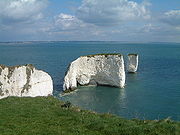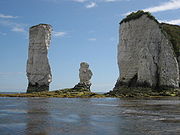
Old Harry Rocks
Encyclopedia


Chalk
Chalk is a soft, white, porous sedimentary rock, a form of limestone composed of the mineral calcite. Calcite is calcium carbonate or CaCO3. It forms under reasonably deep marine conditions from the gradual accumulation of minute calcite plates shed from micro-organisms called coccolithophores....
sea stacks
Stack (geology)
A stack is a geological landform consisting of a steep and often vertical column or columns of rock in the sea near a coast, isolated by erosion. Stacks are formed through processes of coastal geomorphology, which are entirely natural. Time, wind and water are the only factors involved in the...
located at Handfast Point, on the Isle of Purbeck
Isle of Purbeck
The Isle of Purbeck, not a true island but a peninsula, is in the county of Dorset, England. It is bordered by the English Channel to the south and east, where steep cliffs fall to the sea; and by the marshy lands of the River Frome and Poole Harbour to the north. Its western boundary is less well...
in Dorset
Dorset
Dorset , is a county in South West England on the English Channel coast. The county town is Dorchester which is situated in the south. The Hampshire towns of Bournemouth and Christchurch joined the county with the reorganisation of local government in 1974...
, southern England
England
England is a country that is part of the United Kingdom. It shares land borders with Scotland to the north and Wales to the west; the Irish Sea is to the north west, the Celtic Sea to the south west, with the North Sea to the east and the English Channel to the south separating it from continental...
.
Location
Old Harry Rocks lie directly east of StudlandStudland
Studland is a small village on the Isle of Purbeck in the English county of Dorset. It is famous for its beaches and nature reserve. In 2001 Studland had a population of 480, the lowest in 50 years...
, about 4 kilometres northeast of Swanage
Swanage
Swanage is a coastal town and civil parish in the south east of Dorset, England. It is situated at the eastern end of the Isle of Purbeck, approximately 10 km south of Poole and 40 km east of Dorchester. The parish has a population of 10,124 . Nearby are Ballard Down and Old Harry Rocks,...
, and about 10 kilometres south of the large towns of Poole
Poole
Poole is a large coastal town and seaport in the county of Dorset, on the south coast of England. The town is east of Dorchester, and Bournemouth adjoins Poole to the east. The Borough of Poole was made a unitary authority in 1997, gaining administrative independence from Dorset County Council...
and Bournemouth
Bournemouth
Bournemouth is a large coastal resort town in the ceremonial county of Dorset, England. According to the 2001 Census the town has a population of 163,444, making it the largest settlement in Dorset. It is also the largest settlement between Southampton and Plymouth...
.
The chalk headland
Headland
A headland is a point of land, usually high and often with a sheer drop, that extends out into a body of water.Headland can also refer to:*Headlands and bays*headLand, an Australian television series...
s of the Ballard Down
Ballard Down
Ballard Down is an area of chalk downland in Dorset, southern England.The down forms a headland, Ballard Point, between Studland and Swanage bays in the English Channel, and once formed part of a continuous chalk ridge between what are now west Dorset and the Isle of Wight, part of the Southern...
s are owned by the National Trust
National Trust for Places of Historic Interest or Natural Beauty
The National Trust for Places of Historic Interest or Natural Beauty, usually known as the National Trust, is a conservation organisation in England, Wales and Northern Ireland...
. The rocks can be viewed from the Dorset section of the South West Coastal Path.
Geography
The Jurassic CoastJurassic Coast
The Jurassic Coast is a World Heritage Site on the English Channel coast of southern England. The site stretches from Orcombe Point near Exmouth in East Devon to Old Harry Rocks near Swanage in East Dorset, a distance of ....
stretches over a distance of 153 kilometres (95 mi), from Orcombe Point
Orcombe Point
Orcombe Point is a coastal feature near Exmouth, Devon, on the south coast of England. It lies about south of the city of Exeter, southeast of Exmouth town centre and about southwest of Sidmouth....
near Exmouth
Exmouth, Devon
Exmouth is a port town, civil parish and seaside resort in East Devon, England, sited on the east bank of the mouth of the River Exe. In 2001, it had a population of 32,972.-History:...
, in the west, to just beyond the great chalk headland of Ballard Down and Old Harry Rocks here in the east. The coastal exposures along the coastline comprise a continuous sequence of Triassic
Triassic
The Triassic is a geologic period and system that extends from about 250 to 200 Mya . As the first period of the Mesozoic Era, the Triassic follows the Permian and is followed by the Jurassic. Both the start and end of the Triassic are marked by major extinction events...
, Jurassic
Jurassic
The Jurassic is a geologic period and system that extends from about Mya to Mya, that is, from the end of the Triassic to the beginning of the Cretaceous. The Jurassic constitutes the middle period of the Mesozoic era, also known as the age of reptiles. The start of the period is marked by...
and Cretaceous
Cretaceous
The Cretaceous , derived from the Latin "creta" , usually abbreviated K for its German translation Kreide , is a geologic period and system from circa to million years ago. In the geologic timescale, the Cretaceous follows the Jurassic period and is followed by the Paleogene period of the...
rock formations spanning approximately 185 million years of the Earth's history. The rock layers along the Jurassic Coast are tilted towards the east. The oldest part of the coast is found at its west end, while progressively younger rocks form the cliffs here to the east. Old Harry Rocks mark the most easterly point of the Jurassic Coast, a UNESCO World Heritage Site
World Heritage Site
A UNESCO World Heritage Site is a place that is listed by the UNESCO as of special cultural or physical significance...
.
The downlands of Ballard Down are formed of chalk with some bands of flint
Flint
Flint is a hard, sedimentary cryptocrystalline form of the mineral quartz, categorized as a variety of chert. It occurs chiefly as nodules and masses in sedimentary rocks, such as chalks and limestones. Inside the nodule, flint is usually dark grey, black, green, white, or brown in colour, and...
, and were formed approximately 65 million years ago. The bands of stone have been gradually eroded over the centuries, some of the earlier stacks having fallen (Old Harry's original wife fell in 1896), while new ones have been formed by the breaching of narrow isthmuses. Across the water to the east the Needles on the Isle of Wight are usually visible. These are also part of the same chalk band and only a few thousand years ago were connected to Ballard Down.
To form the stacks, the sea gradually eroded along the joints and bedding planes where the softer chalk meets harder bedrock of the rock formations to create a cave. This eventually eroded
Erosion
Erosion is when materials are removed from the surface and changed into something else. It only works by hydraulic actions and transport of solids in the natural environment, and leads to the deposition of these materials elsewhere...
right through to create an arch. The arch subsequently collapsed to leave the stacks of Old Harry, No Man's Land and the gap of St Lucas' Leap. The large outcrop of rock at the end of the cliffs is often referred to as "No Man's Land".
Old Harry itself is now also threatened by erosion, particularly at the foot of the rock. There is a desire to preserve the rocks and protect them from erosion and many teams have been working on saving the formations, including the team headed by Dr C. P. Buckle of the University of Strasbourg
University of Strasbourg
The University of Strasbourg in Strasbourg, Alsace, France, is the largest university in France, with about 43,000 students and over 4,000 researchers....
.
Legend
There are two stories about the naming of the rocks. One legend says that the Devil (traditionally known euphemistically as "Old Harry") had a sleep on the rocks.Another local legend says that the rocks were named after Harry Paye
Harry Paye
Henry Paye , also known as Harry, Page or Arripaye , was a privateer and smuggler from Poole, Dorset in the late 14th and early 15th century, who became a commander in the Cinque Ports fleet....
, the infamous Poole pirate, who stored his contraband nearby.
External links
- Old Harry Rocks - The end of the story Jurassic Coast homepage. Retrieved 2010-11-16

